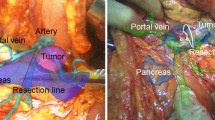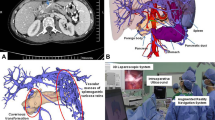Abstract
Background
We have reported the utility of an image display system using augmented reality (AR) technology in hepatobiliary surgery under laparotomy. Among several procedures, we herein report a system using a novel short rigid scope and stereo-scope, both designed specifically for open abdominal navigation surgery, and their clinical application for hepatobiliary and pancreatic surgery.
Methods
The 3D reconstructed images were obtained from preoperative computed tomography data. In our specialized operating room, after paired-point matching registration, the reconstructed images are overlaid onto the operative field images captured by the short rigid scopes. The scopes, which are compact and sterilizable, can be used in the operative field. The stereo-scope provides depth information. Eight patients underwent operations using this system, including hepatectomy in two, distal pancreatectomy in three, and pancreaticoduodenectomy in three patients. The stereo-scope was used in five patients.
Results
All eight operations were performed safely using the novel short rigid scopes, and stereo images were acquired in all five patients for whom the stereo-scope was used. The scopes were user friendly, and the intraoperative time requirement for our system was reduced compared with the conventional method.
Conclusions
The novel short rigid scope and stereo-scope seem to be suitable for clinical use in open abdominal navigation surgery. In hepatobiliary and pancreatic surgery, our novel system may improve the safety, accuracy and efficiency of operations.





Similar content being viewed by others
References
Lamadé W, Vetter M, Hassenpflug P, Thorn M, Meinzer HP, Herfarth C. Navigation and image-guided HBP surgery: a review and preview. J Hepatobiliary Pancreat Surg. 2002;9:592–9.
Marescaux J, Clément JM, Tassetti V, Koehl C, Cotin S, Russier Y, et al. Virtual reality applied to hepatic surgery simulation: the next revolution. Ann Surg. 1998;228:627–34.
Shuhaiber JH. Augmented reality in surgery. Arch Surg. 2004;139:170–4.
Okamoto T, Onda S, Matsumoto M, Gocho T, Futagawa Y, Fujioka S, et al. Utility of augmented reality system in hepatobiliary surgery. J Hepatobiliary Pancreat Sci. 2012;. doi:10.1007/s005340120504z.
Wacker FK, Vogt S, Khamene A, Jesberger JA, Nour SG, Elgort DR, et al. An augmented reality system for MR image-guided needle biopsy: initial results in a swine model. Radiology. 2006;238:497–504.
Das M, Sauer F, Schoepf UJ, Khamene A, Vogt SK, Schaller S, et al. Augmented reality visualization for CT-guided interventions: system description, feasibility, and initial evaluation in an abdominal phantom. Radiology. 2006;240:230–5.
Sugimoto M, Yasuda H, Koda K, Suzuki M, Yamazaki M, Tezuka T, et al. Image overlay navigation by markerless surface registration in gastrointestinal, hepatobiliary and pancreatic surgery. J Hepatobiliary Pancreat Sci. 2010;17:629–36.
Volonté F, Pugin F, Bucher P, Sugimoto M, Ratib O, Morel P. Augmented reality and image overlay navigation with OsiriX in laparoscopic and robotic surgery: not a matter of fashion. J Hepatobiliary Pancreat Sci. 2011;18:506–9.
Ieiri S, Uemura M, Konishi K, Souzaki R, Nagao Y, Tsutsumi N, et al. Augmented reality navigation system for laparoscopic splenectomy in children based on preoperative CT image using optical tracking device. Pediatr Surg Int. 2011. doi:10.1007/s003830013034x.
Cash DM, Miga MI, Glasgow SC, Dawant BM, Clements LW, Cao Z, et al. Concepts and preliminary data toward the realization of image-guided liver surgery. J Gastrointest Surg. 2007;11:844–59.
Hong J, Nakashima H, Konishi K, Ieiri S, Tanoue K, Nakamuta M, et al. Interventional navigation for abdominal therapy based on simultaneous use of MRI and ultrasound. Med Biol Eng Comput. 2006;44:1127–34.
Kurumi Y, Tani T, Naka S, Shiomi H, Shimizu T, Abe H, et al. MR-guided microwave ablation for malignancies. Int J Clin Oncol. 2007;12:85–93.
Conflict of interest
The authors declare no conflict of interest.
Author information
Authors and Affiliations
Corresponding author
About this article
Cite this article
Onda, S., Okamoto, T., Kanehira, M. et al. Short rigid scope and stereo-scope designed specifically for open abdominal navigation surgery: clinical application for hepatobiliary and pancreatic surgery. J Hepatobiliary Pancreat Sci 20, 448–453 (2013). https://doi.org/10.1007/s00534-012-0582-y
Published:
Issue Date:
DOI: https://doi.org/10.1007/s00534-012-0582-y




